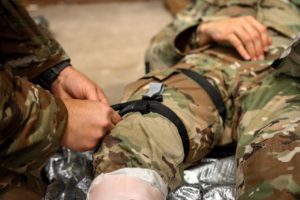Circulation part 2
 When reviewing trauma and concern for haemorrhage, any previously managed catastrophic haemorrhage should be re-checked to ensure you haemorrhage control treatment hasn’t failed. For possible further haemorrhage, the ‘Blood on the floor plus 4’ saying can help in identifying and treating potential further bleeding;
When reviewing trauma and concern for haemorrhage, any previously managed catastrophic haemorrhage should be re-checked to ensure you haemorrhage control treatment hasn’t failed. For possible further haemorrhage, the ‘Blood on the floor plus 4’ saying can help in identifying and treating potential further bleeding;
- Blood on the floor – Initial catastrophic haemorrhage should be identified and dealt with at the start of the survey. This is a review of any managed external haemorrhage where treatment has begun to fail.
- Chest – Bleeding into the thoracic area can reduce circulatory supply significantly. The pleural space of the lungs can hold up to 3 litres of blood. It may be difficult to identify bleeding into the thorax. Keep a high index of suspicion, reviewing the MOI, and looking for evidence of traumatic injury such as bruising, broken ribs, and tenderness. Signs of a haemothorax developing will also identify blood collecting in the pleural space.
- Abdomen – The abdomen is able to hold a large amount of blood within its’ cavity. Signs of injury can include tenderness, guarding, or rigidity on gentle palpation. Bruising or any further obvious injury, e.g., tissue penetration/tearing, must also be considered. Review the MOI and consider if there is a potential for organ shearing injuries due to rapid deceleration.
- Pelvis – The pelvis offers a large area for potential haemorrhage. Signs can include pain around the pelvis, deformity, haematuria, bleeding from the reproductive organs or rectum, and an ‘open’ looking pelvis with splaying of the lower limbs. Also review MOI for the potential forces that may have been involved. A pelvic binder should be applied to reduce the potential space for internal haemorrhage.
- Long bones – The anatomy of long bone structures provide a large potential for internal haemorrhage. Blood loss from femoral shaft fractures can involve between 0.5 – 2 litres of blood. Signs include pain, deformity, compartment syndrome, obvious forms of injury such as tissue penetration, and an index of suspicion for the forces involved in the trauma. Splinting of the limbs can help stem further bleeding by reducing movement of potential sharp bone/fragments from tearing further tissue.
Within the context of certain haemorrhage situations (Trauma, Head injury, post-partum haemorrhage), or major trauma and catastrophic bleeding, Tranexamic Acid can be administered to help reduce the breakdown of clots and further bleeding. Review your own drug guidelines for how and when Tranexamic Acid should be given.